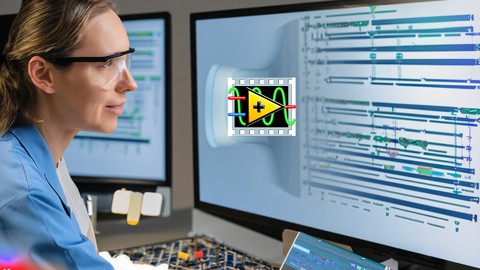
Innovative LabVIEW: Creative Applications and Techniques
Innovative LabVIEW: Creative Applications and Techniques, available at $59.99, has an average rating of 4.1, with 167 lectures, 2 quizzes, based on 27 reviews, and has 199 subscribers.
You will learn about Understand what front panels, block diagrams and connector panels are. Fully understand data types in LabVIEW Use debugging techniques editing and online modes correctly. Create front panels based on look and feel techniques and color theory. Create Sub VIs and document applications in LabVIEW as partner certified developers Create applications under the LabVIEW University model Prepare, Acquire, Analyze and Present Understand and select the available Compact DAQ hardware based on application Recognize and apply LabVIEW best practices in project development. This course is ideal for individuals who are People who want to develop programs in LabVIEW with the highest levels of quality based on good practices and development standards with LabVIEW and who seek to achieve work or business with the best technology companies in the world. or Students, researchers, and engineers in the field of mechanics of electronics, robotics, mechatronics, industries, medicine and … It is particularly useful for People who want to develop programs in LabVIEW with the highest levels of quality based on good practices and development standards with LabVIEW and who seek to achieve work or business with the best technology companies in the world. or Students, researchers, and engineers in the field of mechanics of electronics, robotics, mechatronics, industries, medicine and …
Enroll now: Innovative LabVIEW: Creative Applications and Techniques
Summary
Title: Innovative LabVIEW: Creative Applications and Techniques
Price: $59.99
Average Rating: 4.1
Number of Lectures: 167
Number of Quizzes: 2
Number of Published Lectures: 167
Number of Published Quizzes: 2
Number of Curriculum Items: 169
Number of Published Curriculum Objects: 169
Original Price: ₹799
Quality Status: approved
Status: Live
What You Will Learn
- Understand what front panels, block diagrams and connector panels are. Fully understand data types in LabVIEW
- Use debugging techniques editing and online modes correctly.
- Create front panels based on look and feel techniques and color theory.
- Create Sub VIs and document applications in LabVIEW as partner certified developers
- Create applications under the LabVIEW University model Prepare, Acquire, Analyze and Present
- Understand and select the available Compact DAQ hardware based on application
- Recognize and apply LabVIEW best practices in project development.
Who Should Attend
- People who want to develop programs in LabVIEW with the highest levels of quality based on good practices and development standards with LabVIEW and who seek to achieve work or business with the best technology companies in the world.
- Students, researchers, and engineers in the field of mechanics of electronics, robotics, mechatronics, industries, medicine and …
Target Audiences
- People who want to develop programs in LabVIEW with the highest levels of quality based on good practices and development standards with LabVIEW and who seek to achieve work or business with the best technology companies in the world.
- Students, researchers, and engineers in the field of mechanics of electronics, robotics, mechatronics, industries, medicine and …
This course will take an absolute beginner to intermediate level step by step, with examples, hints, quizzes, and projects. In video lectures, subjects are explained with examples and hints for better & easier programming. At the end of sections, there are quizzes for testing what is learned in the video lectures. There are three projects for using the knowledge of various subjects which were learned in the lectures. In the first lectures of the course, an introduction is done by explaining the LabView environment, LabView tools, and basics. After that, programming fundamentals like case structures, for & while loops, arrays, most of the useful array functions, and reading / writing data from a text file are explained. In the last parts, more LabVIEW-oriented topics like Sub VI’s, property nodes, data acquisition, etc. are explained. Did you know that in industry, it is forbidden to use sequence structures within loops in LabVIEW and that it is best to use state machines for industrial safety reasons? Would you like to know more? Learn this and much more through theoretical sessions and many practices through code exercises that you must complete (including tests to test your knowledge and prepare). This course is designed as a training alternative to the LabVIEW Core I and II courses offered by National Instruments but the best, all in the same course and for a tiny fraction of what it would cost to do them elsewhere. Learn from a master engineer and instructor with more than a decade of experience working on industrial projects and training future professionals in various areas of engineering knowledge and with LabVIEW. Looking at the course and the grades of the students, many have managed to automate their machines and processes, others have achieved new jobs and many others have been certified with National Instruments, I assure you that you will learn so you already have experience programming in LabVIEW.
Course Curriculum
Chapter 1: Introduction
Lecture 1: Introduction
Lecture 2: Download LabVIEW
Lecture 3: New Features of LabVIEW 2023
Chapter 2: Mathematical Expressions
Lecture 1: Introduction
Lecture 2: Mathematical Expression Part 1
Lecture 3: Mathematical Expression Part 2 (Straight Line)
Lecture 4: Mathematical Expression Part 3 (Roots of Quadratic Eqn)
Lecture 5: Mathematical Expression Part 4 (Mathematical Eqn)
Lecture 6: Mathematical Expression Part 5 (Odd and Even Number)
Lecture 7: Mathematical Expression Part 6 (Trignometry)
Lecture 8: Formula Node
Lecture 9: Room Temperature
Lecture 10: Compute Mathematical Equation
Lecture 11: Determinant 2X2
Lecture 12: Factorial using while loop
Lecture 13: Matrix operations
Lecture 14: ODD and Even number in GUI
Lecture 15: Permutation and combination using for loop
Lecture 16: Roots of Quadratic Equation
Lecture 17: Solve linear equations
Lecture 18: Trigonometric function in GUI
Lecture 19: Trapezoid
Lecture 20: Cylinder
Lecture 21: Cone
Lecture 22: Sphere
Lecture 23: Armstrong Number
Chapter 3: Loops
Lecture 1: Introduction
Lecture 2: For Loop
Lecture 3: Case Structure
Lecture 4: Generate Numbers using while loop
Lecture 5: Random Number Using For Loop
Lecture 6: Random Number using While Loop
Lecture 7: Sum of First n natural numbers using for Loop
Lecture 8: Sum of First n natural numbers using while loop
Lecture 9: Weight in Space
Lecture 10: Factorial in GUI
Lecture 11: Color Box
Lecture 12: 1D, 2D, 3D array using For loop
Lecture 13: Array as a loop count in case of For loop
Lecture 14: Flat Sequence Structure P1
Lecture 15: Flat Sequence Structure P2
Lecture 16: Flat Sequence Structure P3
Lecture 17: Flat Sequence Structure P4
Lecture 18: Flat Sequence Structure P5
Lecture 19: Expression Node Example-1
Lecture 20: Expression Node-2
Lecture 21: Expression Node-3
Lecture 22: Mathscript Example -1
Lecture 23: Mathscript Example -2
Lecture 24: Mathscript Example -3
Lecture 25: Mathscript Example -4
Lecture 26: Mathscript Example -5
Lecture 27: Functions in LabVIEW
Lecture 28: Formula Node Example -1
Lecture 29: Formula Node Example -2
Lecture 30: Formula Node Example -3
Lecture 31: Formula Node Example -4
Chapter 4: Logical Expressions
Lecture 1: Introduction Part-1
Lecture 2: Introduction Part-2
Lecture 3: Half Adder
Lecture 4: Full Adder
Lecture 5: Seven Segment Display
Lecture 6: Counter
Lecture 7: BCD to Grey
Lecture 8: Change the state of Boolean Indicator n Times
Lecture 9: DeMorgan’s First theorem
Lecture 10: DeMorgan’s Second theorem
Lecture 11: Digital Electronics using LabVIEW
Lecture 12: 1+A+B+C
Lecture 13: Gray to Binary and Binary to Grey Code
Chapter 5: Arrays in LabVIEW
Lecture 1: Array Part 1
Lecture 2: Array Part 2
Lecture 3: Array functions index array
Lecture 4: Build Array Function
Lecture 5: Array Operations
Lecture 6: Auto Indexing in for loop
Lecture 7: Find out the product of two matrices using matrix function
Lecture 8: Find the determinant of a matrix using the matrix function
Lecture 9: Find out the rank, inverse, transpose, eign value of a matrix using matrix
Lecture 10: In Place Element Structure-1
Lecture 11: In Place Element Structure-2
Lecture 12: In Place Element Structure-3
Lecture 13: In Place Element Structure-4
Lecture 14: In Place Element Structure-5
Chapter 6: Strings in LabVIEW
Lecture 1: Search and Split String
Lecture 2: String function Concatenate and length
Lecture 3: Replace Substring
Lecture 4: Time Formatting
Lecture 5: Format Date and Time string
Lecture 6: CTRL + F in LabVIEW
Lecture 7: Separate each character from string
Chapter 7: Cluster
Lecture 1: Cluster Part 1
Lecture 2: Cluster Part 2
Instructors
-
Salim Khan
LabVIEW Instructor
Rating Distribution
- 1 stars: 1 votes
- 2 stars: 2 votes
- 3 stars: 3 votes
- 4 stars: 9 votes
- 5 stars: 12 votes
Frequently Asked Questions
How long do I have access to the course materials?
You can view and review the lecture materials indefinitely, like an on-demand channel.
Can I take my courses with me wherever I go?
Definitely! If you have an internet connection, courses on Udemy are available on any device at any time. If you don’t have an internet connection, some instructors also let their students download course lectures. That’s up to the instructor though, so make sure you get on their good side!
You may also like
- Top 10 Public Speaking Courses to Learn in December 2024
- Top 10 Affiliate Marketing Courses to Learn in December 2024
- Top 10 Email Marketing Courses to Learn in December 2024
- Top 10 Social Media Management Courses to Learn in December 2024
- Top 10 SEO Optimization Courses to Learn in December 2024
- Top 10 Content Creation Courses to Learn in December 2024
- Top 10 Game Development Courses to Learn in December 2024
- Top 10 Software Testing Courses to Learn in December 2024
- Top 10 Big Data Courses to Learn in December 2024
- Top 10 Internet Of Things Courses to Learn in December 2024
- Top 10 Quantum Computing Courses to Learn in December 2024
- Top 10 Cloud Computing Courses to Learn in December 2024
- Top 10 3d Modeling Courses to Learn in December 2024
- Top 10 Mobile App Development Courses to Learn in December 2024
- Top 10 Graphic Design Courses to Learn in December 2024
- Top 10 Videography Courses to Learn in December 2024
- Top 10 Photography Courses to Learn in December 2024
- Top 10 Language Learning Courses to Learn in December 2024
- Top 10 Product Management Courses to Learn in December 2024
- Top 10 Investing Courses to Learn in December 2024






















